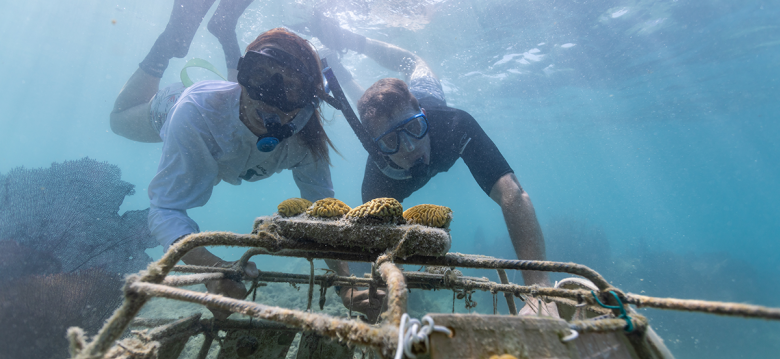
Funded by Darwin Plus Local funds, and with the support of the Department for Environment and Natural Resources and Department of Works and Engineering, The Living Reefs Foundation (LRF) is pursuing a pilot project to use locally grown and rescue corals as a nature-based solution to enhance the protection Bermuda’s coral reefs offer during storm surges and hurricanes. The pilot project is focused on Bermuda’s 1 kilometre Causeway, which is bordered by patchy reefs and a partial man-made boulder barrier.
The ’Causeway’ project, led by Dr Samia Sarkis, aims to demonstrate the use of coral planting to strengthen man-made barriers by turning them into a live and growing reef. Using state of the art technology, LRF has produced young corals from seven boulder-form species. These are grown from microscopic larvae in the Foundation’s land-based hatchery before being transferred to and grown on its coral gardens. Rescue corals, corals which are identified by government officials as in danger of destruction from construction of docks or coastal activities, are also used by LRF. Initially moved to the hatchery to recover, they are then relocated to selected sites where they boost coral cover.
Dr Samia Sarkis said ‘The Darwin Plus fund has given us the capacity to build our infrastructure using state of the art technology. This enables us to investigate the complexities of coral reproduction and reliably produce juveniles, independent of environmental changes and disturbances, and quantify our coral restoration impact at scale. Both awards, received since 2023, are instrumental in significantly advancing our vision: the development of a scalable and cost-effective model in restoring damaged reefs and protecting the coast from storm and hurricane impact.'
The Governor joined Dr Sarkis and her team to view the hatchery at Coney Island and learn about the research. He then joined Dr Sarkis in Castle Harbour waters to attach some laboratory grown coral to an underwater structure. Each coral is given a local identifier to help monitor growth: this coral was called “Palmy” in homage to The Governor’s resident cat Palmerston.
The Governor said ‘The UK supported work being done by the Living Reef Foundation, in close partnership with Government of Bermuda environmental experts, has potentially global significance. With the threat of sea level rise, and increasingly extreme weather events, we need to look to nature-based solutions to help protect our coastlines. The work being done in Bermuda is critical to understanding how to promote coral growth in the laboratory for successful placement at sea.’
The data obtained from this study will inform officials on alternative strategies to build long term resilient breakwaters and increase their cost-effectiveness by reducing maintenance costs normally incurred by man-made barriers.
It will also provide a powerful mapping tool which can be used to quantify impacts to the seabed by vessel groundings, and baseline mapping for Environmental Impact Assessments. One of the main outputs of the project is a technical manual on the restoration using photogrammetry – using overlapping photographs to create a 3D model - which will be made available through the Foundation’s website.
A spokesperson for DENR said ‘Since 2018, the Department of Environment and Natural Resources (DENR) has supported the operational needs of the Living Reefs Foundation by issuing Protected Species Licences and providing laboratory space. The Foundation focuses on restoring coral reefs impacted by direct human activity, such as boat groundings and coastal development. Using lab-grown corals, Living Reefs aims to reduce pressure on natural populations and develop scalable methods to grow genetically diverse corals faster so that reef restoration and coastal protection can be done in an accelerated timeframe.’
